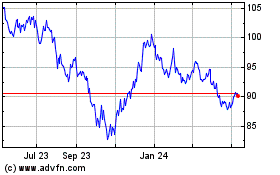BOND REPORT: 30-year Treasury Yield Snaps Six-day Streak Of Declines
25 July 2017 - 7:31AM
Dow Jones News
By Sunny Oh
Treasury traders will await the FOMC statement on Wednesday for
signs of how the central bank is processing weak economic data
Treasury yields climbed Monday as traders braced for a Federal
Reserve policy meeting starting Tuesday that could help to provide
further clarity on the central bank's approach to tackling sluggish
inflation and scaling back its $4.5 trillion asset portfolio.
The yield on the 30-year bond added 3.1 basis points to 2.833%,
ending a six-day streak of declines. The yield on the 10-year
Treasury note rose 2.1 basis points to 2.253%, while the 2-year
note's yieldgained 2.1 basis points to 1.365%.
In particular, long-dated Treasury yields came under selling
pressure, pushing yields, which move inversely to prices, higher as
investors took money off the table following a two-week surge in
government-bond prices, on the back of a wave of lackluster
economic data and dovish central bank speeches. Hundreds of
millions of dollars left from the largest exchange-traded fund
tracking long-dated Treasurys(TLT) in the week ending July 21
(http://www.marketwatch.com/story/investors-withdraw-from-long-dated-treasurys-etf-2017-07-24).
Although market participants expect few changes
(http://www.marketwatch.com/story/stocks-brace-for-volatility-as-earnings-peak-weak-fed-meeting-loom-2017-07-22)
to the language of the coming updated policy statement, they will
closely watch for indications that weakening data have unnerved
members of the Federal Open Market Committee. That said, the
central bank tends to be reluctant to make major tweaks to policy
language on FOMC meetings without a corresponding news
conference.
"The economy definitely seems to be shifting into lower gear,
whether the Fed chooses to amend the statement and address some of
those problems, this could move the market," said Mary Ann Hurley,
vice president of fixed-income trading at D.A. Davidson.
Adding to the downbeat reports, the International Monetary Fund
on Sunday lowered its U.S. growth forecast for 2017 to 2.1% from
2.3% as economists cut their expectations for President Donald
Trumps's pro-growth agenda. The president's one-two-three punch of
tax cuts, deregulation and infrastructure spending, were the
signature pledges that helped to get him into the Oval Office and
which weighed on Treasurys, initially jolting yields firmly higher
back in November. But the failure to overhaul the Affordable Care
Act, known as Obamacare, has cast doubt on his ability to leverage
from a Republican majority on Capitol Hill and push through other
legs of his legislative agenda.
This reflected that "fiscal policy will be less expansionary
going forward than previously anticipated," according to their
World Economic Outlook update
(http://www.imf.org/en/Publications/WEO/Issues/2017/07/07/world-economic-outlook-update-july-2017).
See: IMF cuts U.S. growth forecast for 2017, 2018
(http://www.marketwatch.com/story/imf-cuts-us-growth-forecast-for-2017-2018-2017-07-24)
Despite the muted backdrop, many still expect the Fed to signal
its plans to reduce its balance sheet starting as early as
September, even as it pushes back the schedule for normalizing
interest rates. Though the tapering of the Fed's asset portfolio
has caused some jitters about the potential impact
(http://www.marketwatch.com/story/will-the-feds-balance-sheet-unwind-catch-investors-by-surprise-2017-05-03)
on the Treasury market, the gradual pace of the roll-off is
unlikely to trigger investors' flight from the largest market for
government paper in the world, said some analysts. A reduction in
the central bank's asset portfolio, accumulated during the 2008-'09
financial crisis, can also serve to raise borrowing costs,
tightening lending conditions on Wall Street.
Read:Jamie Dimon says QE unwind could catch investors by
surprise
(http://www.marketwatch.com/story/jamie-dimon-says-qe-unwind-could-catch-investors-by-surprise-2017-07-11)
"The FOMC appears to have put rate normalization on the back
burner for the time being," wrote Ward McCarthy, chief financial
economist for Jefferies.
On the data front, existing-home sales for June came in at an
annual rate of 5.52 million
(http://www.marketwatch.com/story/existing-home-sales-fall-in-june-as-market-retrenches-after-hot-spring-season-2017-07-24),
the lowest pace since February, missing an average forecast of
economists polled by MarketWatch of 5.58 million.
Looking ahead, the Treasury Department is slated to sell $88
billion of U.S. government paper in tenors ranging from 2 years to
7 years.
Elsewhere, the German 10-year bond yield was at 0.51%. German
bond yields slipped last week after European Central Bank President
Mario Draghi's dovish remarks caused the euro to surge above $1.16,
moving investors out of equities and into eurozone sovereign debt
(http://www.marketwatch.com/story/treasury-yields-fall-as-dovish-comments-from-ecbs-draghi-fuel-bond-buying-2017-07-21).
(http://www.marketwatch.com/story/treasury-yields-fall-as-dovish-comments-from-ecbs-draghi-fuel-bond-buying-2017-07-21)
(END) Dow Jones Newswires
July 24, 2017 17:16 ET (21:16 GMT)
Copyright (c) 2017 Dow Jones & Company, Inc.
iShares 20 plus Year Tre... (NASDAQ:TLT)
Historical Stock Chart
From Mar 2024 to Apr 2024

iShares 20 plus Year Tre... (NASDAQ:TLT)
Historical Stock Chart
From Apr 2023 to Apr 2024
